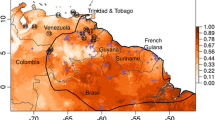Abstract
Modifications to the Massaciuccoli wetland (Central Italy) caused by various human activities were examined in relation to the distribution of the local Bittern (Botaurus stellaris) population. From 1993 to1998 we documented the changing distribution pattern of booming males within the marsh, while at the same time gathering information on human utilisation of the habitat. The evolution of the marsh’s layout overtime has been accurately delineated by developing a Geographical Information System. Local customs of marsh utilisation, in particular the illegal setting of fires and the enlarging of hunting pools, had major impacts on its features. The vegetation beds, dominated by Cladium mariscus, proved to be a patchwork mosaic of different-aged plants (from the last fire or cutting), whose densities therefore increased over time. Booming male distribution was uneven within the marsh and varied from one year to the next. The youngest vegetation beds covered more than 50% of the 50 m-buffer zones defined around booming males. A logistic regression model showed that Bitterns favoured unfragmented young vegetation beds (1–3 years). Consideration of the current state of affairs suggests that the necessary renewal of the vegetation could be best achieved through co-ordinated actions carried out in rotation on predetermined plots, covering at least 20 ha in extent and managed at least every 4 years.
Similar content being viewed by others
References
Adamo M.C., Puglisi L. and Baldaccini N.E. Factors Affecting Bittern Distribution in a Mediterranean Wetland. Bird Conservation International, (Botaurus Stellaris) 14: 153–164.
Bibby C.J, Burgess N.D. and Hill D.A. 1992. Bird Census Techniques. RSPB Publication Sandy, Academic Press.
C.J. Bibby J. Lunn (1982) ArticleTitleConservation of reed beds and their avifauna in England and Wales Biological Conservation 23 167–186 Occurrence Handle10.1016/0006-3207(82)90074-X
D.C. Dearborn L.L. Sanchez (2001) ArticleTitleDo Golden-cheeked warblers select nest locations on the basis of patch vegetation? Auk 118 1052–1057
S.R. Derrickson S.R. Beissinger N.F.R. Snyder (1998) Directions in endangered species research J.M. Marzluff R. Sallabanks (Eds) Avian Conservation: Research and Management Island Press Washington 111–123
S.W. Gabrey A.D. Afton (2001) ArticleTitlePlant community composition and biomass in gulf coast chenier plain marshes: responses to winter burning and structural marsh management Environmental Management 27 281–293 Occurrence Handle10.1007/s002670010149 Occurrence Handle1:STN:280:DC%2BD2cvgtFShuw%3D%3D Occurrence Handle11116385
A. Gauckler M. Kraus (1965) ArticleTitleZur Brutbiologie der Grossen Rohrdommel (Botaurus stellaris) Vogelwelt 86 129–146
G. Gilbert P.K. McGregor G. Tyler (1994) ArticleTitleVocal individuality as a census tool: practical considerations illustrated by a study of two rare species Journal of Field Ornithology 65 335–348
E.J.M. Hagemeijer M.J. Blair (1997) The EBCC Atlas of European Breeding Birds, Their Distribution and Abundance Poyser London
C.J. Hawke P.V. Josè (1996) Reedbed Management for Commercial and Wildlife Interest RSPB Publication Sandy, UK
Hollis T. 1992. The causes of wetland loss and degradation in the mediterranean. In: Finlayson C.M., Hollis T. and Davis T.J. (eds), Managing Mediterranean wetlands and their birds, Pro-ceedings of an IWRB International Symposium, Grado, Italy, February 1991. IWRB Special Publication No. 20, pp. 83–90.
J. Jones (2001) ArticleTitleHabitat selection studies in avian ecology: a critical review Auk 118 557–562
J.A. Kushlan H. Hafner (Eds) (2000) Heron Conservation Academic Press London
S. Manel C. Williams S.J. Ormerod (2001) ArticleTitleEvaluating presence-absence models in ecology; the need to account for prevalence Journal of Applied Ecology 38 921–931 Occurrence Handle10.1046/j.1365-2664.2001.00647.x
Morrison M.L., Marcot B.G. and Mannan R.W. 1992. Wildlife-Habitat Relationships: Concepts and Applications. The University of Wisconsin Press, .
Puglisi L. and Adamo C. Cano ergo sum: individual voice discrimination in Bittern (Botaurus stellaris). Auk (in press).
L. Puglisi M.C. Adamo N.E. Baldaccini (2003) ArticleTitleSpatial behaviour of radiotagged Eurasian Bitterns (Botaurus stellaris) Avian Science 3 133–143
M.G. Raphael K.S. McKelvey B.M. Galleher (1998) Using geographical information systems and spatially explicit population model for avian conservation : a case study J.M. Marzluff R. Sallabanks (Eds) Avian Conservation: Research and Management Island Press Washington 65–74
R.J. Robel J.N. Briggs A.D. Dayton L.C. Hulbert (1970) ArticleTitleRelationship between visual obstruction measurements and weight of grassland vegetation Journal of Range Management 23 295–297
K.K. Steward H. Ornes (1975) ArticleTitleThe autoecology of sawgrass in the Florida everglades Ecology 56 162–171 Occurrence Handle1:CAS:528:DyaE2MXhsFCns7Y%3D
A. Tamisier O. Dehorter (1999) Camargue Canards et Foulques Fonctionnement et devenir dȁ9un prestigieux quartier dȁ9hiver Centre Ornithologique du Gard. Nîmes
G.M. Tucker M.I. Evans (1997) Habitats for Birds in Europe: A Conservation Strategy for the Wider Environment BirdLife International (BirdLife Conservation Series No. 6) Cambridge U.K
G.A. Tyler K.V. Smith D.J. Burges (1998) ArticleTitleReedbed management and breeding bitterns Botaurus stellaris in the U.K. Biological Conservation 86 257–266
R. Van Diggelen W.J. Molenaar A.M. Kooijman (1996) ArticleTitleVegetation succession in a floating mire in relation to management and hydrology Journal of Vegetation Science 7 809–820
M.A. Villard E.V. Schmidt B.A. Maurer (1998) Contribution of spatial modeling to avian conservation J.M. Marzluff R. Sallabanks (Eds) Avian Conservation: Research and Management Island Press Washington 49–64
G.C. White R.A. Garrot (1990) Analysis of Wildlife Radio-Tracking Data Academic Press San Diego
Author information
Authors and Affiliations
Corresponding author
Rights and permissions
About this article
Cite this article
Puglisi, L., Claudia Adamo, M. & Emilio Baldaccini, N. Man-induced habitat changes and sensitive species: a GIS approach to the Eurasian Bittern (Botaurus stellaris) distribution in a Mediterranean wetland. Biodivers Conserv 14, 1909–1922 (2005). https://doi.org/10.1007/s10531-004-2121-x
Received:
Accepted:
Issue Date:
DOI: https://doi.org/10.1007/s10531-004-2121-x




